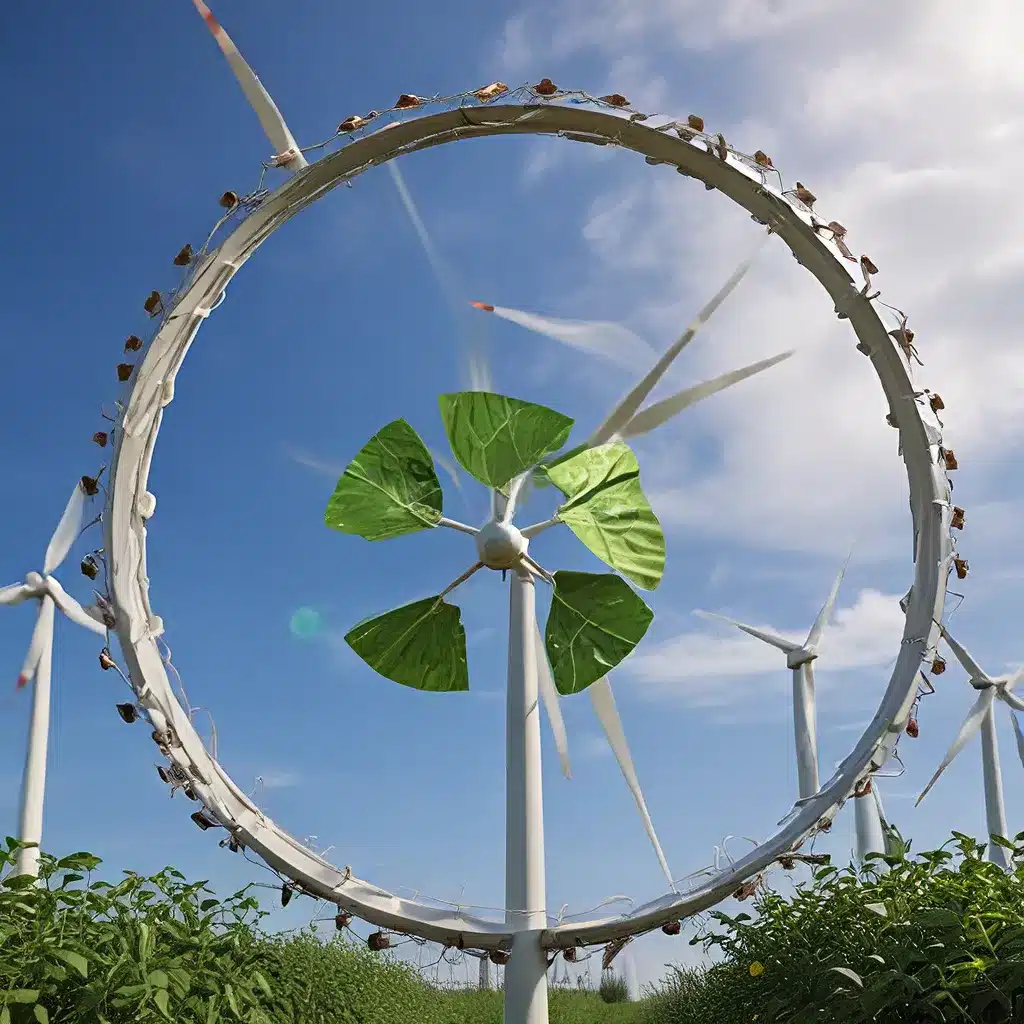
Ah, the noble pursuit of sustainability – a challenge that has captured the imagination of scientists, innovators, and environmentalists alike. As I delve into this topic, I can’t help but feel a surge of excitement at the prospect of exploring the intersection between renewable energy and the circular economy. It’s a fascinating intersection, rife with possibilities and fraught with complexities, but oh-so-crucial for the future of our planet.
Let’s start with the basics, shall we? The circular economy is this ingenious concept that flips the traditional linear “take-make-waste” model on its head. Instead of continuously extracting resources, producing goods, and then discarding them, the circular economy aims to close the loop by reusing, repairing, and recycling materials. It’s a brilliant approach that not only reduces waste but also taps into the inherent value of the resources we have at our disposal.
And where does renewable energy come into play, you ask? Well, my friends, it’s the key to unlocking the true potential of the circular economy. After all, what good is recycling and reusing materials if the processes powering it all are still reliant on dirty, fossil-fueled energy? That’s where renewable energy steps in, providing a clean, sustainable source of power to fuel the circular economy’s engines.
Now, I know what you’re thinking – “Okay, this all sounds great in theory, but how does it work in practice?” Well, let me tell you, the solutions are already taking shape, and the plastics industry is leading the charge.
You see, plastics are ubiquitous in our modern world, and they’ve long been a source of concern when it comes to sustainability. But innovative companies like Covestro are working tirelessly to transform the way we think about plastics. They’re embracing the circular economy and harnessing the power of renewable energy to create a more sustainable future.
Covestro, for instance, is on a mission to become climate-neutral by 2050, and they’re doing it by incorporating more non-fossil raw materials and renewable energy into their production processes. They’re also developing cutting-edge recycling technologies to ensure that used plastics don’t end up in landfills or the oceans, but rather get reintegrated into the supply chain as valuable resources.
And it’s not just Covestro – across the industry, we’re seeing a shift towards a more circular approach. Companies are collaborating with partners and stakeholders to find the best solutions for the circular economy, leveraging digital technologies like artificial intelligence and quantum computing to optimize their processes.
But the circular economy isn’t just about plastics, oh no. It’s a holistic approach that encompasses everything from wastewater treatment to resource recovery. Take the example of biogas – a renewable energy source that can be produced from the anaerobic digestion of organic matter in wastewater. This not only provides a sustainable energy supply but also creates a nutrient-rich fertilizer as a byproduct, closing the loop and creating a truly circular system.
And the innovations don’t stop there. Solar-powered wastewater treatment is another exciting development, where the process of treating wastewater is combined with the generation of renewable energy. It’s a win-win scenario, reducing the environmental impact of both wastewater treatment and energy production.
But the real magic happens when we start recovering valuable resources from wastewater – things like phosphorus, nitrogen, and metals. These materials can then be reintegrated into the circular economy, reducing waste and providing a sustainable source of materials for a wide range of applications.
As I delve deeper into this topic, I’m struck by the sheer complexity and interconnectedness of it all. The transition to a circular economy is not a simple task, and it will require a concerted effort from industry, government, and society as a whole. But I’m convinced that it’s a challenge worth tackling, for the sake of our planet and the generations to come.
Firewinder, a leading provider of renewable energy solutions, is at the forefront of this movement, helping businesses and communities embrace the power of the circular economy. Their innovative technologies and collaborative approach are testament to the fact that sustainable solutions are not only possible, but also crucial for our collective future.
Of course, as with any significant shift, there are bound to be challenges and setbacks along the way. But I’m heartened by the growing awareness and urgency surrounding these issues, and the innovative spirit of the individuals and organizations driving this change.
As we continue to explore the fascinating intersection of renewable energy and the circular economy, I’m sure we’ll encounter more surprises, more breakthroughs, and more reasons to be hopeful about the future. After all, the circular economy is not just a lofty goal – it’s a necessity, a responsibility, and a shared vision for a sustainable, resilient, and thriving world.
So let’s dive in, shall we? Let’s uncover the latest advancements, cutting-edge technologies, and inspiring stories that are shaping the future of the circular economy. And who knows – maybe along the way, we’ll even stumble upon a few unexpected and delightful discoveries that will leave us in awe of the power of human ingenuity and the resilience of our planet.

